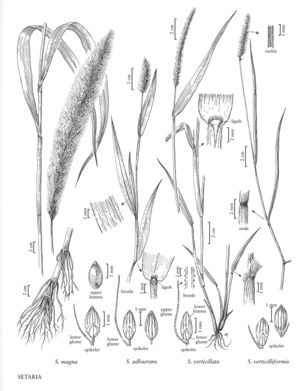Difference between revisions of "Setaria verticillata"
FNA>Volume Importer |
imported>Volume Importer |
||
| (8 intermediate revisions by 2 users not shown) | |||
| Line 4: | Line 4: | ||
|publications= | |publications= | ||
|common_names=Hooked bristlegrass;Setaire verticillee | |common_names=Hooked bristlegrass;Setaire verticillee | ||
| + | |special_status={{Treatment/ID/Special_status | ||
| + | |code=I | ||
| + | |label=Introduced | ||
| + | }} | ||
|basionyms= | |basionyms= | ||
|synonyms={{Treatment/ID/Synonym | |synonyms={{Treatment/ID/Synonym | ||
|name=Chaetochloa verticillata | |name=Chaetochloa verticillata | ||
| − | |authority= | + | |authority= |
| + | |rank=species | ||
}} | }} | ||
|hierarchy=Poaceae;Poaceae subfam. Panicoideae;Poaceae tribe Paniceae;Setaria;Setaria subg. Setaria;Setaria verticillata | |hierarchy=Poaceae;Poaceae subfam. Panicoideae;Poaceae tribe Paniceae;Setaria;Setaria subg. Setaria;Setaria verticillata | ||
| Line 19: | Line 24: | ||
-->{{Treatment/Body | -->{{Treatment/Body | ||
| − | |distribution=Conn.;N.J.;N.Y.;Wash.;Del.;Wis.;W.Va.;Pacific Islands (Hawaii);Kans.;N.Dak.;Nebr.;S.Dak.;Wyo.;N.Mex.;Tex.;La.;Pa.;D.C;N.H.;R.I.;Nev.;Va.;Colo.;Md.;Calif.;Ark.;Vt.;Ill.;Ind.;Iowa;Okla.;Ariz.;Idaho;Maine;Mont.;Oreg.;Mass.;Ohio;Utah;Mo.;Minn.;Mich.;B.C.;Man.;N.W.T.;Ont.;Que.;Ky. | + | |distribution=Conn.;N.J.;N.Y.;Wash.;Del.;Wis.;W.Va.;Pacific Islands (Hawaii);Kans.;N.Dak.;Nebr.;S.Dak.;Wyo.;N.Mex.;Tex.;La.;Pa.;D.C.;N.H.;R.I.;Nev.;Va.;Colo.;Md.;Calif.;Ark.;Vt.;Ill.;Ind.;Iowa;Okla.;Ariz.;Idaho;Maine;Mont.;Oreg.;Mass.;Ohio;Utah;Mo.;Minn.;Mich.;B.C.;Man.;N.W.T.;Ont.;Que.;Ky. |
| − | |discussion=<p>Setaria verticillata is a European adventive that is now common throughout the cooler regions of the contiguous United States and in southern Canada. It is an aggressive weed in the vineyards of central California. Reports of S. carnei Hitchc. from North America are based on misidentification of this species.</p><!-- | + | |discussion=<p><i>Setaria verticillata</i> is a European adventive that is now common throughout the cooler regions of the contiguous United States and in southern Canada. It is an aggressive weed in the vineyards of central California. Reports of S. carnei Hitchc. from North America are based on misidentification of this species.</p><!-- |
| − | --><p>Setaria verticillata resembles the S. adhaerans but differs in having longer panicles and spikelets, sheath margins that are ciliate distally, and blades that are scabrous, not hairy. Setaria verticillata is a more northern species than S. adhaerans, but their ranges overlap in the Flora region.</p> | + | --><p><i>Setaria verticillata</i> resembles the <i>S. adhaerans</i> but differs in having longer panicles and spikelets, sheath margins that are ciliate distally, and blades that are scabrous, not hairy. <i>Setaria verticillata</i> is a more northern species than <i>S. adhaerans</i>, but their ranges overlap in the Flora region.</p> |
|tables= | |tables= | ||
|references= | |references= | ||
| Line 30: | Line 35: | ||
-->{{#Taxon: | -->{{#Taxon: | ||
name=Setaria verticillata | name=Setaria verticillata | ||
| − | |||
|authority=(L.) P. Beauv. | |authority=(L.) P. Beauv. | ||
|rank=species | |rank=species | ||
| Line 37: | Line 41: | ||
|basionyms= | |basionyms= | ||
|family=Poaceae | |family=Poaceae | ||
| − | |distribution=Conn.;N.J.;N.Y.;Wash.;Del.;Wis.;W.Va.;Pacific Islands (Hawaii);Kans.;N.Dak.;Nebr.;S.Dak.;Wyo.;N.Mex.;Tex.;La.;Pa.;D.C;N.H.;R.I.;Nev.;Va.;Colo.;Md.;Calif.;Ark.;Vt.;Ill.;Ind.;Iowa;Okla.;Ariz.;Idaho;Maine;Mont.;Oreg.;Mass.;Ohio;Utah;Mo.;Minn.;Mich.;B.C.;Man.;N.W.T.;Ont.;Que.;Ky. | + | |illustrator=Linda A. Vorobik;Annaliese Miller |
| + | |illustration copyright=Utah State University | ||
| + | |distribution=Conn.;N.J.;N.Y.;Wash.;Del.;Wis.;W.Va.;Pacific Islands (Hawaii);Kans.;N.Dak.;Nebr.;S.Dak.;Wyo.;N.Mex.;Tex.;La.;Pa.;D.C.;N.H.;R.I.;Nev.;Va.;Colo.;Md.;Calif.;Ark.;Vt.;Ill.;Ind.;Iowa;Okla.;Ariz.;Idaho;Maine;Mont.;Oreg.;Mass.;Ohio;Utah;Mo.;Minn.;Mich.;B.C.;Man.;N.W.T.;Ont.;Que.;Ky. | ||
|reference=None | |reference=None | ||
|publication title= | |publication title= | ||
|publication year= | |publication year= | ||
| − | |special status= | + | |special status=Introduced |
| − | |source xml=https:// | + | |source xml=https://bitbucket.org/aafc-mbb/fna-data-curation/src/200273ad09963decb8fc72550212de541d86569d/coarse_grained_fna_xml/V25/V25_1416.xml |
|subfamily=Poaceae subfam. Panicoideae | |subfamily=Poaceae subfam. Panicoideae | ||
|tribe=Poaceae tribe Paniceae | |tribe=Poaceae tribe Paniceae | ||
Latest revision as of 17:56, 11 May 2021
Plants annual. Culms 30-100 cm; nodes glabrous. Sheaths glabrous, margins ciliate distally; ligules to 1 mm, densely ciliate; blades 5-15 mm wide, flat, abaxial surfaces scabrous. Panicles 5-15 cm, tapering to the apices; rachises retrorsely rough hispid; bristles solitary, 4-7 mm, retrorsely scabrous. Spikelets 2-2.3 mm. Lower glumes about 1/3 as long as the spikelets, obtuse, 1(3)-veined; upper glumes nearly as long as the spikelets; lower paleas about 1/2 as long as the spikelets, broad; upper lemmas finely and transversely rugose; upper paleas similar to the upper lemmas. 2n = 18, 36, 54, 72, 108.
Distribution
Conn., N.J., N.Y., Wash., Del., Wis., W.Va., Pacific Islands (Hawaii), Kans., N.Dak., Nebr., S.Dak., Wyo., N.Mex., Tex., La., Pa., D.C., N.H., R.I., Nev., Va., Colo., Md., Calif., Ark., Vt., Ill., Ind., Iowa, Okla., Ariz., Idaho, Maine, Mont., Oreg., Mass., Ohio, Utah, Mo., Minn., Mich., B.C., Man., N.W.T., Ont., Que., Ky.
Discussion
Setaria verticillata is a European adventive that is now common throughout the cooler regions of the contiguous United States and in southern Canada. It is an aggressive weed in the vineyards of central California. Reports of S. carnei Hitchc. from North America are based on misidentification of this species.
Setaria verticillata resembles the S. adhaerans but differs in having longer panicles and spikelets, sheath margins that are ciliate distally, and blades that are scabrous, not hairy. Setaria verticillata is a more northern species than S. adhaerans, but their ranges overlap in the Flora region.
Selected References
None.
